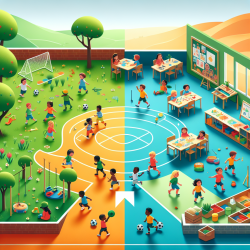Introduction
In the realm of Early Childhood Education (ECE), the importance of fostering environments conducive to physical activity cannot be overstated. The recent study titled "Associations between Community Built Environments with Early Care and Education Classroom Physical Activity Practices and Barriers" sheds light on how community environments influence physical activity practices within ECE settings.
Key Findings from the Study
The study conducted in Oklahoma reveals that a significant number of ECEs are located in "Activity Deserts," areas lacking access to parks and playgrounds, and with low walkability scores. Despite these challenges, ECEs have been found to provide a protective micro-environment that supports physical activity.
Interestingly, the study found that while the presence of parks and playgrounds within a 10-mile radius positively influenced physical activity practices in Family Child Care Homes (FCCHs), this was not the case for Head Starts and Community-Based Childcare (CBC) settings. This suggests that FCCHs may rely more on community resources for physical activity opportunities.
Implications for Practitioners
For practitioners in the field of ECE, these findings underscore the importance of understanding the role of community environments in shaping physical activity practices. Here are some actionable steps practitioners can take:
- Advocate for improved community resources such as parks and playgrounds, especially in areas identified as Activity Deserts.
- Develop partnerships with local community organizations to enhance access to physical activity resources.
- Implement creative indoor physical activities to compensate for the lack of outdoor resources.
- Engage in professional development opportunities focused on integrating physical activity into daily routines.
Encouraging Further Research
While the study provides valuable insights, it also opens avenues for further research. Practitioners are encouraged to explore how different community environments across various regions impact ECE practices. Additionally, investigating the effectiveness of policy interventions aimed at improving physical activity environments can provide further guidance for ECE settings.
Conclusion
The study highlights the crucial role community environments play in influencing physical activity practices within ECE settings. By understanding these dynamics, practitioners can better advocate for resources and implement strategies that promote healthy physical activity habits in young children.
To read the original research paper, please follow this link: Associations between Community Built Environments with Early Care and Education Classroom Physical Activity Practices and Barriers.










